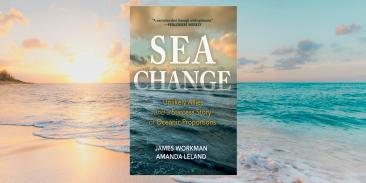Organizations Voice Concern Over Federal Flooding Plan for NY-NJ Harbor
Advocates Launch Campaign Announcing Their Shared Demands for an Overhaul of the Army Corps’ Plan, Calling for a More Comprehensive Approach
NEW YORK, NEW YORK – August 16, 2023 – Today a broad group of environmental, civic and environmental justice organizations announced their shared demands for a major overhaul of the $52.6 billion storm surge protection plan proposed by the U.S. Army Corps of Engineers (Corps), calling for a comprehensive approach that addresses multiple flood hazards and prioritizes historically disadvantaged communities in the New York-New Jersey metropolitan region.
More than 25 organizations in New York and New Jersey are calling for critical changes to the New York-New Jersey Harbor and Tributaries Study plan, stating that the Corps’ plan fails to protect environmental justice communities and is myopic, focusing primarily on one type of flooding – coastal storm surge. Their demands center on four primary priorities:
- Addressing all types of flooding by building resilience to the full combination of flood risks that the region experiences, such as heavy rains, rising groundwater and “sunny day” tidal flooding. According to the best available science, some of these risks are expected to worsen and become permanent in certain areas with sea level rise and storm surge. The Water Resources Development Act directs the Corps to consider these threats, but they haven’t yet been included.
- Centering frontline communities by incorporating and fast-tracking the priorities of those most affected by flooding, building from existing community-supported plans and robust public engagement.
- Prioritizing people over property value by incorporating equity and social and environmental benefits into cost-benefit analyses, and ensuring that environmental justice communities like the South Bronx, NY and Perth Amboy, NJ aren’t left out.
- Maximizing nature and minimizing harm by using the Corps’ Engineering With Nature program and fully accounting for the environmental benefits and impacts of each approach.
Advocates are calling for the Corps to integrate these elements into a revised version of the plan. The group is pressing for the plan’s non-federal sponsors, New York, New Jersey and New York City, to hold the Corps accountable to the law and the priorities expressed by communities before moving forward with the proposed plan.
In the coming weeks, New York, New Jersey and New York City agency leadership will meet with the Corps to determine whether to move forward with the existing plan or proceed with a different approach.
“New York-New Jersey Harbor is home to our nation’s densest coastal metropolis. Any plan to mitigate flooding should address all the types of flooding we face, using the best available science,” said Kate Boicourt, director for Environmental Defense Fund’s Climate Resilient Coasts and Watersheds New York-New Jersey program. “Without changes, the Corps’ plan puts communities at risk, perpetuates inequities and neglects the opportunity to build the future that communities deserve. In the 21st century, we need 21st century solutions that work better for people and nature. New York, New Jersey and the City of New York must work with local communities and the Corps to invest in a holistic approach to flood planning that benefits communities for generations to come.”
"So many of us know that the New York-New Jersey Harbor and Tributaries Study has the potential to substantially protect many communities from the impacts of climate change. Yet the plan is essentially a structural engineering response to Hurricane Sandy. It does not take into account the multiple climate risks we now see occurring here and around the globe. Waterfront Alliance and the Rise to Resilience Coalition have long called for a plan that is holistic, protects the most flood vulnerable communities and prioritizes nature-based and non-structural solutions. Ahead of the agency decision milestone, we strongly urge our non-federal sponsors to make sure the Corps adheres to the hundreds of public comments they have received, Justice40 Initiative and Water Resources Development Act before green-lighting this study for Congress," said Cortney Koenig Worrall, president and CEO of Waterfront Alliance.
"Now is the moment to fix the Army Corps plan and get the smart, comprehensive flood protections we truly need for New York and New Jersey. Massive storm gates will not protect us from the full range of flooding hazards that are growing by the day: heavy downpours, rising groundwater and sea level rise. They would only make our pollution problems worse and harm the life in our waters,” said Tracy Brown, president of Riverkeeper. “Riverkeeper and our partners across the metropolitan region are united in this call for a smarter approach than what the Army Corps is proposing. Now we need our state and local leaders to step up and insist on a plan that is better for our communities and better for our environment, as Congress has mandated. At this critical juncture we need to get this right."
"The path to resilient, sustainable and just solutions is clear – building upon the foundation of community-led plans that center people over profits. As El Puente envisions it, our nation's response to flooding must be a collaborative effort that reflects all of our needs, like the communities we represent in the Southside of Williamsburg and Bushwick. We must forge a path that leads to the empowerment of frontline communities. Ensuring viable climate futures not only for a few, but for us all," said Marco A. Carrión, executive director of El Puente.
"The Natural Areas Conservancy firmly believes that the U.S. Army Corps of Engineers must take a more holistic approach to coastal protection that considers community and social benefits, evaluates economic impacts with equity and environmental justice at the forefront, and carefully evaluates and minimizes impacts to the incredible ecosystems and biodiversity that New York City supports, including our natural areas and wetlands. Coastal protection should work with, instead of against, nature to help make our communities more resilient, while protecting the environment we all depend on for urban life," said Sarah Charlop-Powers, executive director of the Natural Areas Conservancy.
“The Army Corps’ $52 billion dollar taxpayer-funded proposal jeopardizes the future of New York Harbor’s national parks and needlessly subjects vulnerable communities to common and frequent types of floods. The Corps must hit the pause button and design a better plan that protects residents and parklands from all kinds of climate-induced flooding, as federal law requires,” said Lauren Cosgrove, campaign director for the National Parks Conservation Association (NPCA). “The future of New York’s Harbor rests in the hands of the Army Crops. NPCA calls on Congress, the states of New York and New Jersey and the City of New York to hold the Corps accountable.”
"A fifty billion dollar plan that doesn't protect our communities is no plan at all," said Amy Chester, managing director of Rebuild by Design. "The communities have been clear in what they want to see – high engagement, high transparency and collaboration built into the project design of multi-hazard and multi-solutional interventions. We should not settle for less."
“For a plan of such magnitude, the New York-New Jersey Harbor and Tributaries Study lacks the complexity needed to address the multiple coastal flooding threats that are increasingly impacting New York City. We need a holistic water management solution that is responsive to community needs and aspirations, addresses multiple climate hazards, innovatively works with nature and is flexible and adaptable long into the future. The U.S. Army Corps of Engineers must work more deeply and collaboratively with affected stakeholders to achieve these goals,” said Elizabeth Goldstein, president of the Municipal Art Society of New York.
“As storm surges are exacerbated by climate change, they have become one of the largest-scale threats facing New York and New Jersey,” said Sahana Rao, staff attorney at Natural Resources Defense Council. “A one-size-fits-all approach like storm surge barriers is inevitably going to leave some folks less protected than others, and we have seen historically how that often means leaving marginalized communities open to harm. Instead, a robust public process is needed to better understand the Army Corps’ tentative plan, incorporate community feedback and assess areas for improvement. Residents also deserve a commitment from the Army Corps to address this issue holistically, as required by federal law.”
“The Army Corps’ NY-NJ HATS proposal would perpetuate injustices and inequities in the South Bronx,” said Arif Ullah, executive director of South Bronx Unite. “Its proposed on-land seawall for Mott Haven-Port Morris would permanently disconnect community members from the waterfront, which is currently burdened with a heavy concentration of polluting facilities. Instead of a seawall, what we need is a community-centered, nature-based plan that creates meaningful coastal resilience and desperately needed open green space. And we already have such a plan: South Bronx Unite worked with our community to develop the Mott Haven-Port Morris Waterfront Plan, which was prioritized by the NYS Department of Environmental Conservation. The Army Corps must work with us to implement this plan, not HATS, which it developed without our input.”
“Our region’s waterfront communities and ecosystems are enduring a multitude of impacts from climate change that are only growing worse and that disproportionately hurt communities who have borne the burden of marginalization, discrimination and poor land use decisions for too long,” said Robert Freudenberg, vice president for Energy & Environment at Regional Plan Association. “As worsening climate impacts threaten the very viability of the region, there is perhaps no more important study being carried out than HATS, and no greater need than to get the final approach right. Put simply, we need to see a better plan from the U.S. Army Corps of Engineers that takes on all flooding threats, does right by our communities, and better integrates and protects the natural systems of our Harbor Estuary.”
More information: GetNYNJFloodPlanRight.com
With more than 3 million members, Environmental Defense Fund creates transformational solutions to the most serious environmental problems. To do so, EDF links science, economics, law, and innovative private-sector partnerships to turn solutions into action. edf.org
Media Contact
Latest press releases
-
New York Finalizes Greenhouse Gas Reporting Requirements for Major Polluters
December 2, 2025 -
Canada-Alberta MOU a Disappointing Retreat on Oil & Gas Methane Regulation
November 27, 2025 -
Trump EPA Delays Methane Pollution Protections from Oil and Gas Industry Despite Health Risks, Energy Waste, Widespread Opposition
November 26, 2025 -
New York’s Climate Law Experiences Another Delay
November 25, 2025 -
Trump’s EPA Abandons Defense of National Soot Standard That Saves Lives
November 25, 2025 -
New Jersey Settlement: Protecting Residents and Their Environment
November 24, 2025











